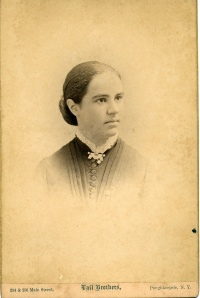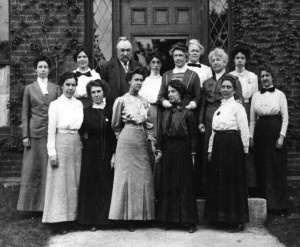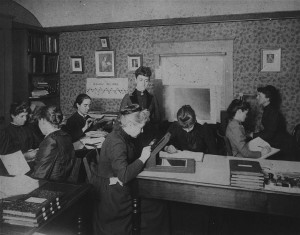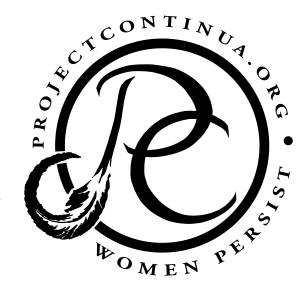- Photograph of Antonia Maury from her senior year at Vassar College
- ‘Pickering’s Harem’ standing in front of Building C at the Harvard College Observatory, 13 May 1913.
- Harvard computers, circa 1890. Seated, third from left, with magnifying glass: Antonia Maury; standing, at center: Williamina Fleming
Antonia Caetana Maury (1866-1952) Maury was born on March 21, 1866, in Cold Springs, New York. Her father, Mytton Maury, was an Episcopal minister and amateur naturalist. Her mother, Virginia (Draper) Maury, was the sister of Henry Draper, the first person to photograph stellar spectra. Antonia Maury was also the granddaughter of John Draper, the person credited with producing the first photograph of the moon.[1] As a child, Maury was educated at home by her father before attending Vassar College, where her professor, Maria Mitchell, sparked her interest in studying the stars. She graduated in 1887 with honors in physics, philosophy, and astronomy.[2]
Maury was introduced to Edward Charles Pickering after her father wrote to the Harvard College Observatory to see if they might have a job for his daughter as one of the Harvard Computers. Her aunt, Mary Anna (Palmer) Draper, had created the Henry Draper Memorial Fund, which was being used to fund astronomy research in honor of her late husband. The largest project became known as the Henry Draper Catalogue, a list of 225,000 stellar spectra and their characteristics gathered from studying thousands of glass plate photographs of the night sky.[3] In 1888, Pickering assigned Maury to the task of stellar classification and the investigation of the spectra of bright northern stars, because of her training in math and physics at Vassar.[4]
New photographic plates showed much more detail than the ones previous Harvard Computers such as Williamina Fleming had used. Therefore the old classification system was not adequate to describe the characteristics of the spectra for Maury’s needs. She devised a more complex system of 22 groups designated by Roman numerals. However, even these groups weren’t enough to define all the existing variety, so each numeral also had three possible divisions.[5] Many astronomers later acknowledged that her classification was better; after a few tweaks, it was used for many astronomical discoveries.[6]
Maury’s own stellar classification catalogue was published in 1897 and titled “Spectra of Bright Stars Photographed with the 11-inch Draper Telescope as Part of the Henry Draper Memorial.”[7] The conclusions were based on Maury’s examination of 4,800 photographs and gave detailed analysis of 681 bright northern stars.[8] Her catalogue became the first observatory publication credited to a woman.[9]
Unfortunately, Maury and Pickering clashed on many levels, and Maury resigned and returned to the observatory several times over the years.[10] She left the observatory for a teaching post in 1891, only to return in 1893, where she was met with little enthusiasm from Pickering and Mary Anna Draper. Feeling mistreated, she left again in 1894.[11] For the next years, Maury traveled, lectured, tutored, and conducted environmental work.[12] She gave four lectures on astronomy at Cornell University in 1899, as well as others in New York. During this time, Maury also tutored private pupils and held occasional teaching positions.[13]
Maury often visited the Harvard College Observatory to conduct research on spectroscopic binaries, pairs of stars so close together that the naked eye couldn’t tell them apart — only the spectra revealed their separation. She and Pickering had first identified these doubles in 1889.[14] Maury officially rejoined Harvard’s observatory staff again in 1918, and worked more collegially with the next observatory director, Harlow Shapley, who took over from Pickering in 1921.[15] In 1919-20 she received the Pickering Fellowship for women, and conducted research on spectroscopic binaries with special focus on a star system in the constellation Lyra, Beta Lyrae.[16] Maury also spent significant time working with the spectral analysis of the star Mizar A. From the measurements of 70 plates she confirmed that Mizar A is, indeed, a binary system, which Pickering had suspected.[17]
Antonia Maury was awarded the Annie Jump Cannon Prize in 1943 for her classification system and her work on the star catalogue. She died on January 8, 1952.[18]
[1] Alan Hirshfeld, Starlight Detectives: How Astronomers, Inventors, and Eccentrics Discovered the Modern Universe (New York: Bellevue Literary Press, 2014), 97; and Bessie Zaban Jones and Lyle Gifford Boyd, The Harvard College Observatory: The First Four Directorships, 1839-1919 (Cambridge, MA: Harvard University Press, 1971), 396.
[2] Lisa Yount, A to Z of Women in Science and Math (New York: Facts on File, Inc., 1999), 140.
[3] Yount, A to Z, 140.
[4] Jones and Boyd, The Harvard College Observatory, 396-7.
[5] Jones and Boyd, The Harvard College Observatory, 236-7.
[6] Yount, A to Z, 140.
[7] Jones and Boyd, The Harvard College Observatory, 399.
[8] Jones and Boyd, The Harvard College Observatory, 236-7; and Solon Bailey, The History and Work of Harvard Observatory 1839-1927 (New York and London: McGraw-Hill Book Company, 1931), 152.
[9] Yount, A to Z, 140.
[10] Ibid.
[11] Jones and Boyd, The Harvard College Observatory, 397-8.
[12] Yount, A to Z, 140.
[13] Jones and Boyd, The Harvard College Observatory, 399.
[14] Yount, A to Z, 140.
[15] Yount, A to Z, 141.
[16] Jones and Boyd, The Harvard College Observatory, 400.
[17] Hirshfeld, Starlight Detectives, 234.
[18] Jones and Boyd, The Harvard College Observatory, 400; and Yount, A to Z, 141.
Bibliography:
Bailey, Solon. The History and Work of Harvard Observatory 1839-1927. New York and London: McGraw-Hill Book Company, 1931.
Hirshfeld, Alan. Starlight detectives: How Astronomers, Inventors, and Eccentrics Discovered the Modern Universe. New York: Bellevue Literary Press, 2014.
Jones, Bessie Zaban and Lyle Gifford Boyd. The Harvard College Observatory: The First Four Directorships, 1839-1919. Cambridge, MA: Harvard University Press, 1971.
Young, Monica. “Digitizing Harvard’s Century of Sky”. Sky and Telescope, May 14, 2013. Accessed February 3, 2015.
Yount, Lisa. A to Z of Women in Science and Math. New York: Facts on File, Inc., 1999.
Page citation:
Lindsay Smith. “Antonia Maury.” Project Continua (March 15, 2015): Ver. 1, (date accessed), http://www.projectcontinua.org/antonia-maury/
Tags: Age of Global Conflict, Astronomers, Educators, Industrial Revolution, North America



